
“Kubrick: and beyond the cinema frame”
An in-depth analysis of
2001: A SPACE ODYSSEY
Text copyright © by Rob Ager 2008
(last updates added 2015)
CHAPTER 12
2001: A FAKE ODYSSEY?
I’d now like to bring your attention to several details that reveal the “alien intelligence” theme of 2001 to be a deliberately fabricated “cover story”.
Let’s start with the council meeting scene and pay some attention to the three figures sat with their backs to us. Floyd is in the middle chatting to his colleague Bill, who is on the right. Floyd uses his finger to roughly draw an invisible monolith in mid-air. Bill responds by swiftly arcing his extended hand 90 degrees, perhaps encouraging us to mentally rotate the monolith.


Notice also that at the far end of the room we see not only a large white cinema screen, but a roughly three foot tall white monolith, which the speaker stands behind. And from where Floyd is sat his head is framed by this small white monolith.
During his extremely vague speech Floyd makes a very important comment “… congratulations on your discovery”. His two colleagues, who still have their backs to us, immediately respond by glancing at each other.

This all seems to suggest that Floyd and his colleagues already know what the monolith is, though it could just be Kubrick offering more visually encoded clues for our benefit.
The “congratulations” could also be addressing we the audience for having cracked the monolith / screen connection and thus having arrived outside the false narrative. Remember also that the Jupiter mission took place aboard a ship called the Discovery. So the term “congratulations on your discovery” may be another indicator that during the surreal ending of the film Bowman was actually asleep and dreaming aboard the ship that he had seized back from HAL.
In the council meeting we don’t actually get to see the briefing that Floyd was about to give - only his introduction, but a clue can be found in the footage that HAL plays as he is being shut down. Floyd is seen sitting at a desk with an image of an unidentified planet or moon projected onto a screen behind him – the words National Council of Astronautics are written across the bottom of the screen. This desk looks very similar to the one he was sitting at in the council meeting and so the recording of his message was probably part of the briefing session.

If this is true then we have found a timeline error in the “alien intelligence” narrative. If the monolith sent it’s “radio emission” to Jupiter during the excavation scene … then how could the Jupiter mission instruction video have been recorded in the council briefing, which took place in advance?
Also, what exactly is the purpose of the Jupiter mission? Even if we ignore all the interpretation in this review and just follow the standard “alien intelligence” version of the story, the Jupiter mission intent is still very vague. Why the secrecy and compartmentalization? Just what exactly are the crew supposed to do when they reach Jupiter and its many moons? If there is a monolith there then how will they know where to find it? As HAL puts it “there are some extremely odd things about this mission”. HAL also talks about the “strange stories floating around before we left”, which could double up as an aesthetic hint about the floating monolith and its alignment with the cinema screen.
The scene where Bowman and Poole watch themselves broadcast in a television interview has a scripted feel to it. The true purpose of the mission is not told and so the whole broadcast smacks of propaganda. As they watch this footage the astronauts are eating processed fake food. Like Alex at the end of A Clockwork Orange, they are literally being fed a pack of lies, but here they are eating their own lies.
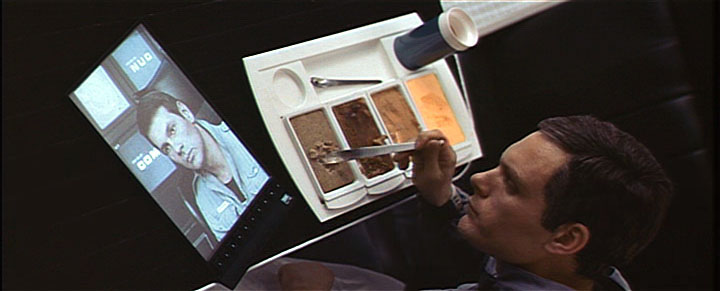
The metaphor of fake food as an indicator of lying is also featured on the moon bus. Floyd eats a fake chicken sandwich while discussing the monolith, and Halvorsen, who is eating a fake ham sandwich, tells Floyd that his speech “beefed up morale”. A strange detail of this scene is the lighting, which has an ethereal glow. The music played during the exterior shots of this moon bus is called Lux Aeterna, which translates as “Eternal Light”. This all ties in with the concept of Floyd and his friends as the self-proclaimed “enlightened ones” as described in the previous chapter of this review. Watch the light carefully in the moon busscene. When Floyd bites into his synthetic chicken sandwich, the luminous light source suddenly dims.

Is this an unintended detail? Possibly not. It links in perfectly with the concept of Floyd and his colleagues as the falsely illuminated ones.
Notice also the blasé humour with which the three men discuss the excavated “finding”.
This is all said within ear shot of the pilots, which totally contradicts Floyd’s lecture to the council about the “need for absolute secrecy”. He also flatly refused to talk about the monolith when questioned by Smyslov when he could have eased Smyslov’s concerns by offering an alternate explanation of some kind.Floyd, “I’d just like to say I think you guys have done a wonderful job. I appreciate the way you’ve handled this thing.”
Halvorsen, “Well, the way we see it, i t’s out job to do this thing the way you want it done and we’re only too happy to oblige.”
... Floyd, “I don’t suppose you know what the damn thing is?”
Halvorsen, “Well, all we know is it was buried four million years ago.”
Floyd, “Well, you guys have really come up with something.”
Remember also that Floyd spoke in the council room about “the grave potential for social shock and cultural disorientation contained in this present situation … if the facts were made public without proper preparation and conditioning.” I believe this to be one of the most important lines of dialogue in the whole movie. The term “adequate preparation and conditioning” is a user-friendly term for propaganda. Obviously they are trying to either hide or falsify some major event that will widely affect the human race.
An explanation for all this may be that the council are about to stage a discovery of extra-terrestrial life. The rumours of “something being dug up on the moon” and the “reliable intelligence reports” of something having been found of an “unknown origin” can be understood as standard propaganda practice. In propaganda public opinion is often tested or conditioned by deliberate information “leaks” or falsified rumours. The party responsible for putting out the information encourages it to spread behind the scenes, yet publicly denies its authenticity - just as Floyd does when questioned by Smyslov. So the conversation on the moon bus could be Floyd and his council colleagues deliberately jesting with each other in ear shot of the pilots in order to further spread the rumour.
Looking at the council meeting again it’s not difficult to notice that the meeting has been scripted by its three central characters. Floyd and Bill are privately whispering to each other before the meeting starts. After Floyds introduction speech, he asks if there are any questions. Bill then asks how long the cover story will have to be maintained. Of course Bill already knows the answer because he has just been privately chatting to Floyd. Notice how utterly silent the rest of the group are. If you strip away the pretence, Floyds talk is basically a scripted question and answer session. It is a mystery as to whether the rest of the council are in on the propaganda stunt or are being manipulated into spreading the rumours.
In an ultimate reflection of the films surface narrative, which is basically a “cover story” for Kubrick’s hidden narratives, the famous poster of 2001 features the deceptive tagline “An epic drama of adventure and exploration”.
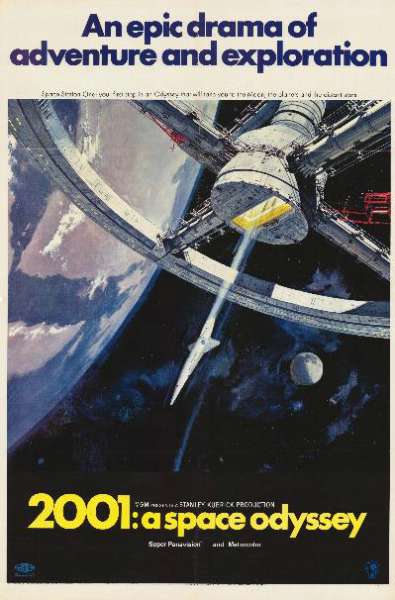
The entire dialogue of the council meeting scene is embedded with hidden narrative innuendos. An amusing example is the presence of a parallel or mirrored reality, as featured in the excavation site. Dr Halvorsen introduces Floyd to the group and then walks around the right side of the table and back to his seat in a way that virtually mirrors Floyds movement around the table on the left side. The two characters also look very much alike and when Floyd addresses the group he says “nice to be back again” as if he has just got up and introduced himself twice. He then delivers a message from a Dr Howell, perhaps encouraging us to "howl" with laughter at the double identity joke.

He tells the group that their discovery “may well be one of the most important in the history of science”, but he mentions nothing about what that discovery is. If this film is about the discovery of alien intelligence then why doesn’t he say something specific to that effect? He does however pass on the “appreciation” of the aforementioned myterious "Doctor Howell" for the many “sacrifices” they have had to make. Again, this is very vague. What sacrifices?
After cutting to a close up shot, Floyd makes comments about “conflicting views” and “opposition to the cover story” and that he sympathizes with the groups “negative views”. These comments could apply to some of the deliberate visually continuity errors, such as images being flipped vertically and horizontally, or to the hidden narratives.
The camera angle now switches back to a wide shot as Floyd says “well, this is the view of the council”. Again this could be hinting at the mirrored reality theme. Is Floyd referring to his own physical view of the room or to our view (the films audience)? The position Floyd is stood in while speaking this line is also probably the position the camera was in when his pre-recorded briefing of the Jupiter mission was filmed. Floyd would have been sat in his chair in the middle of the desk.

He next says “the purpose of my visit here is to gather additional facts and opinions … on the situation … and to prepare a report recommending when and how the … news should eventually be announced”. Again, why so vague? What is “the situation” that he is waffling about and why does he hesitate before speaking the word “news”? Perhaps because the “news” announcement is a grand lie to the public.
There is another interpretation for the meeting room scene, which could be running in parallel with the theme of a faked alien artefact discovery, and this is most evident in an unbelievable continuity error. All of the characters movements as they walk about the council room are occurring under full gravity identical to Earth’s. This is supposed to be a moon base, but the photographer practically runs around the table.

Everywhere else in 2001 we find careful attention paid to convincing gravity effects. The hostesses wear grip shoes that fasten their feet to the floor and aboard the Discovery Poole and Bowman walk carefully about the pod bay indicating that they are wearing grip shoes as well.
Now I know it’s easy to pass off the Earth like gravity in the council meeting as a simple continuity error, but we only need to look at the shots leading up to the council scene to discredit such a dismissive explanation. As Floyds landing craft approaches the Clavius base three astronauts are seen standing on a lunar mountain top with their backs to us, overlooking the base.
Notice that they are discussing something and pointing down at the base. One of them then walks away to the left and starts preparing to take a photo.



The choreography of these three men parallels that of Floyd and his two closest colleagues in the council room and both scenes feature photographers, but the walking movements on the lunar surface are slow and careful by comparison.

So why would Kubrick depict low gravity in the lunar surface shot and then completely forget about it for the council meeting scene? Surely somebody on set would have pointed this out to the director. No, the gravity differences are most likely exaggerated as part of yet another hidden narrative.
So have you guessed what this other hidden narrative is yet? Well, basically it is communicating another controversial subject … the fake moon landings theories. Now before you shake your head in disbelief and disagreement, remember what I said about conspiracy theories and the polarization effect. The truth often lies somewhere in the middle. My intention here is not to try and convince you that the moon landings were faked. I am simply interpreting what I believe to be subjective themes expressed in 2001. Even if Kubrick did believe the moon landings were faked then that doesn’t make it so.
So let’s explore this idea further. The astronaut on the mountain top prepares to take a photo as Floyds landing ship floats in on the left. It doesn’t take a great leap of logic to realize that he will be taking photos of Floyds moon landing, which is paralleled by the photographer taking photos of Floyd in the council room.

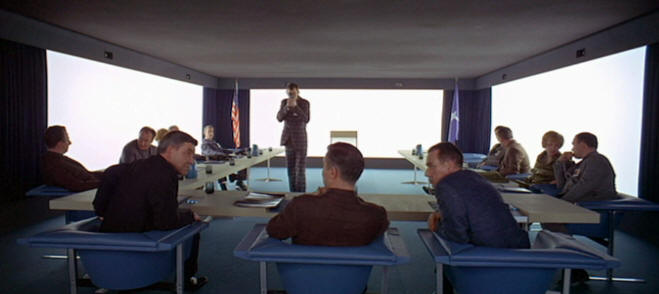
Considering that the meeting is supposed to be highly secretive, why the hell is this guy taking pictures anyway? Why is he only taking photos of Floyd and why the various angles?
For potential insight into this puzzle I recommend you seek out a documentary film called "Dark Side of the Moon". This strange film explores a rumour that Stanley Kubrick may have filmed fake moon landing footage for the US government in return for massive budgets on his films. The film states that Kubrick was approached on the contention that if communication with the astronauts were to fail during the moon landings then false backup footage would be needed to keep the public satisfied about this great historical event. The film features interviews with Kubricks wife, Christiane, and other people associated with the director. It shows photographs of fake moon landing sets in which Kubrick had apparently left photographs on the ground to try and expose the landing as a hoax … and so on. At the end of the film it is revealed that the interviews have been scripted and that the whole documentary is actually poking fun at moon landing conspiracy theories. To prove this Christiane and the other people interviewed are shown in the end credits getting their lines wrong and laughing.
One of the weirdest things about the “dark side of the moon” mockumentary is that political heavyweights such as Henry Kissinger and ex-CIA director Donald Rumsfeld are also shown laughing at the end of the film, as if they also were acting in the scripted interviews. Why would such powerful and influential men take time out of their schedule to act in a silly conspiracy mockumentary? Note: one of the members on the forum for this site recently explained that the director of Dark Side of the Moon, William Karel, lifted interview footage from another of his own documentary films called The World According to Bush and placed that footage out of context in Dark Side of the Moon. It's odd that a supposedly serious documentary film maker would risk his own reputation by making a film such as Dark Side of the Moon. Is the film a determined attempt to scramble the debate about the whether the moon landings were staged? Did William Karel really believe the moon landings were fake, while disguising his message within a "comedy" film? Was Karel just going through a weird phase and decided to make a useless film for his own amusement?
Even after almost forty years the conspiracy theories over the moon landings have not subsided. There are all kinds of video documentaries, articles and web pages that argue both sides of the debate and the subject has even made it’s way into other Hollywood movies such as the fake Mars landings in the sci-fi film Capricorn One.

Before showing you the other moon landing conspiracy clues in 2001, I must mention that the first US moon landings were broadcast on the 20th July 1969, but the film 2001 was released on the 6th April 1968 – over a year in advance. So how could Kubrick have been giving out conspiracy messages about a major event that hadn’t even happened yet? As I said the truth is often somewhere in the middle ground. Here are some possibilities.
My contention is that, right or wrong, Kubrick was convinced the moon landing project was a conspiracy in the making and hence he embedded a fake moon landing narrative in 2001. Here are my additional observations in this respect.

The long sequence of colour filtered landscape shots before the Renaissance room seem random, but the fact that they take up such a lengthy section of the film suggests that they are of paramount importance. They are often perceived to be the landscapes of an alien planet, but why are they so unconvincing?

With the huge budget and talented crew he had, Kubrick could have filmed something much more impressive - the lunar landscape special effects. from earlier in the film, demonstrate what he was capable of.
There are absolutely no signs of organic life in the "alien" terrain – only rock formations, but yet we see vast expanses of water, which suggest there should be life.


Some research sources claim that these shots were actually black and white footage leftover from Kubricks previous film Dr Strangelove. Here are some actual landscape frames from the Dr Strangelove DVD.



Notice the similarities? If the landscapes of 2001s ending were taken from Strangelove stock footage then they would of course have been colourized. So being that the colourization process in 2001 involved one colour replacing the bright areas of the image and another colour replacing the dark areas, if we restore the dark areas and turn the image to monochrome what do we see?




The black and white versions could definitely pass for Dr Strangelove footage.
Taking this theme further let's now take the landscapes from the Dawn of Man sequence and view them both in monochrome and with similar colour filters to those used in the "alien" landscape sequence.






Do you see what I'm getting at? By experimenting with colour filters we find that the landscapes of both the Dawn of Man sequence and the "alien" planet are virtually indistinguishable from each other. By turning both sets of landscapes to monochrome and removing the unrealistic colour filters we're left with footage that could also pass for the lunar surface ... espescially if we darken the skies.


The only giveaway in the shots below is that the they are taken from low altitude where bones and shrubbery are visible.


To explore these colour themes further try watching a dvd of the film with the colour settings on your tv turned all the way down. The rocky formations of the three landscape sequences - dawn of man, lunar surface, alien terrain - are one and the same.
I believe this was Kubrick's way of trying to tell us that the lunar landscape footage broadcast in 1969 was filmed on Earth in some rocky region that could be made to pass for the moon, and that false filtering was somehow used to make the footage convincing.
Sound far-fetched? Well, remember I'm not saying that the moon landings actually were faked, just that Kubrick believed they were.
Let's go back to the lunar landscape scenes and pay close attention to the footage. Most of these lunar lansdscape shots have also been colour filtered in the film, but to a very faint degree that bypasses our conscious attention. Depending on which shot you’re looking at the moonscapes are either blue, green, purple or yellow.





Here they are again, but in black and white. Can you see how the original shots were faintly colourized?





To make the colour filters easier to see here are the same shots, but with the colour saturation and contrast turned way up. Notice that that each shot was filtered with a slightly different colour.





If we now add a different colour to the darker areas then the moonscapes are not much different to the rocky landscapes at the end of the film.

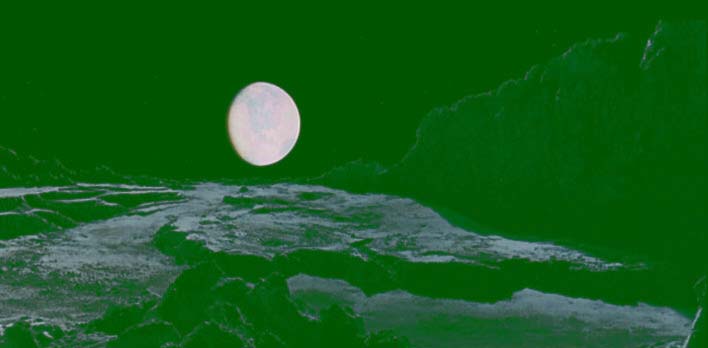

The most convincing link between the lunar shots and the colour filtered landscapes is the following image of Floyds craft descending with Earth in the background. This shot has a green tint and a spherical blue haze over the centre.
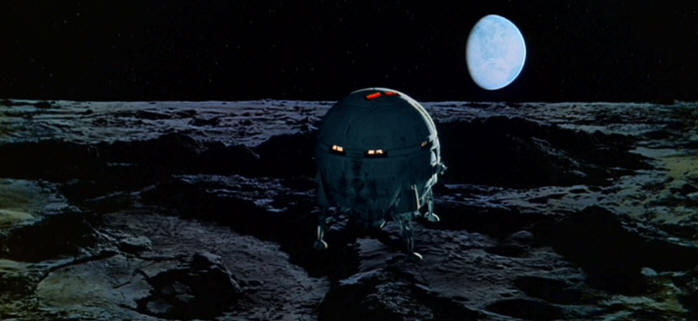
And here it is with increased saturation and contrast.

This kind of spherical haze is prominent in many of the “alien” landscape shots after the stargate.



It’s extremely subtle messaging. The rocky landscapes during the dawn of man, the lunar surface shots and the colour filtered alien landscape sequence are the same terrain. The presence of lakes and oceans in the end sequence drives the message home that these landscapes are definitely not the moon. They are Earth.
Note: Something else worth considering about the presence of oceans is that water is a valued resource to all life, but the apes are seen battling over a tiny pool of muddy water in the films opening sequence.
Exaggerated colour filtering is a part of 2001s visual code and is boldly expressed in several of the marketing posters and production stills. Compare the following poster with its corresponding footage from the dvd. Not only have the colours been drastically altered in the poster, but the footage of Poole's parents has been turned to black and white. The orange goggles Frank is wearing also communicate the colour filter theme.



The following selection of posters and stills also feature interesting colour messaging.







I also found this production photo of Floyd and his colleagues entering the excavation site, but have been unable to identify whether Kubrick requested the filter be used or if somebody else added the colours later.

Given all these clues, it could be that the lunar landing shots of 2001 are actually fake moon footage that Floyd has been showing to his colleagues in the council room. This would mean that the council meeting takes place either on Earth or on the Torus station. This also explains the presence of full gravity and would be yet another variation on the "film within a film" motif put forth in previous chapters.
The vague council meeting dialogue also fits well with the contention that Floyd and his colleagues are conspiring to publicly stage the moon landings (as well as intending to fake the discovery of extra terrestrial intelligence). For example, the comment “I completely sympathize with your negative views” could be an innuendo about the colourization themes. The comment about “the potential for cultural shock and social disorientation contained in this present situation” may be a warning that the operation must be done convincingly.
There are even more details in the council meeting scene to support this fake moon landing interpretation. One of the most famous of the moon landing conspiracy claims is that the US flag is seen blowing in the wind on the lunar surface even though there is no atmosphere on the moon. Here we see a US flag, which is very prominent in some of the close ups of Floyd, and there’s an unidentified blue flag on the right. Both of these flags are seen faintly moving during the wide shots, as if blown by a mysterious wind.




Also look at the ceiling. Its unsophisticated mottled grey could pass for an out of focus view of the moon’s surface. The colours of the floor, chairs, water flasks and desks are also similar to those of a cloudy sky.

If we apply the vertical flipping suggested by the letter “i” in the octahedron sequence and the matching celings of the Torus station that reappear as floor tiles in the renaissance room, then we may actually be seeing a subtle depiction of the fake moon surface accompanied by an Earth sky - and of course the US flag.

Lastly, in another classic Kubrick film, The Shining, young Danny is seen wearing a sweater with a cartoonish depiction of an Apollo moon mission rocket - perhaps hinting that the moon landings are equivalant to a childs fairy tale.